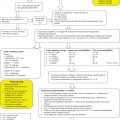Chapter 22
Eating Disorders
Graeme O’Connor and Dasha Nicholls
Introduction
Eating disorders are psychiatric disorders with diagnostic criteria based on psychological, behavioural and physiological characteristics. Eating disorders comprise anorexia nervosa (AN), bulimia nervosa (BN) and associated eating disorders. Detailed classifications and treatment methods of eating disorders can be found in the Diagnostic and Statistical Manual of Mental Disorders 4th edition (DSM IV) [1] and the International Classification of Diseases 10th revision (ICD-10).
AN has a point of prevalence of 0.48%–0.7% in adolescent females, with diagnosis peaking between 16 and 17 years of age. The incidence begins to increase around the age of 10 years [2] and has been reported in children as young as 7 or 8 years [3]. BN occurs in approximately 1%–2% of the adolescent population while clinically significant bulimic behaviours occur in an additional 2%–3% [4]. BN is rare below the age of 13 years [3].
Disturbances in nutrition may be particularly harmful during vulnerable periods of brain development and physical growth, resulting in excessive and potentially permanent physical and psychological consequences [5]. Nutritional intervention in the treatment of eating disorders is an essential component and therefore the dietitian is an essential member of the multidisciplinary team, drawing on specialist skills in areas of nutrition, physiology and behaviour change. Dietitians should not treat eating disorders as sole practitioners and must work within a multidisciplinary team [6].
Screening and diagnosis
Paediatricians and general practitioners often refer young people with a history of weight loss to the dietitian. It is therefore not unusual for dietitians to be the first health professionals to identify or question a possible eating disorder.
Anorexia nervosa – clinical features
AN is a psychiatric disorder that predominately affects females. It varies in severity, with extreme nutritional restriction accompanied by other associated behaviours such as binge eating, self-induced vomiting, purging, over-exercising and self-harm [7]. Whether the incidence of AN is increasing is a matter of some debate but there is consensus that the mortality rate is amongst the highest of all psychiatric disorders [8]. The cognitive distortion associated with AN results in dieting behaviour and an intense fear of weight gain and fatness. Generally there is no loss of appetite, but satisfaction in feeling ‘empty’ and hungry overrides the need to eat, and weight loss is viewed as an achievement; thus sufferers have limited desire to change [9].
Identifying an eating disorder in the early stages is difficult due to the deceptive nature of the disease, especially when presentation is atypical. In addition, lack of awareness that AN can occur in children and boys may lead to a delay in referral, diagnosis and treatment [10], although this may be changing. Clinical signs of AN include
- Weight loss – in AN body weight is maintained at least 15% below that expected. The World Health Organization (WHO) definition of underweight and the diagnostic criterion for AN is a percentage body mass index (%BMI) below 85% (where %BMI is BMI/median BMI for age and gender). For the majority of the population a healthy %BMI will fall between 95% and 105% [1, 11]. A consequence of low weight is that pubertal development is halted, resulting in either a delay in reaching menarche or secondary amenorrhoea, which can have implications on bone health. Physical signs of poor nutrition and low weight include sunken cheeks, temporal lobes and eyes; dull thinning hair; lanugo hair; cold extremities and feeling cold; and delayed puberty [12].
- Avoidance of food – this can occur gradually over time, with subtle restriction of nutritional intake including eliminating snacks, reducing portion sizes, hiding food and missing meals. Furthermore, avoidance of food can transfer into the social setting: the young person will avoid eating out due to a lack of control over food preparation, or it may interrupt rigid exercise routines or other ‘rules’. Conversely, the young person can be overly involved with food shopping, meal preparation and baking but will avoid eating themselves. Patients will often have an extensive knowledge about the calorie content of food but this is often the limit of their understanding about food and nutrition. It is a common misconception that young people with AN have a good comprehension of nutrition but they are often unable to understand information or interpret it correctly; hence the importance of nutrition education for them [13].
- Morbid preoccupation with weight and/or shape – energy dense foods are avoided through fear of gaining weight or a change in body shape that may accompany it. Girls perceive their stomach and thighs as particularly fat, whereas boys may be more concerned about musculature and are more likely to exercise excessively.
- Poor self-esteem – feelings of ineffectiveness are extremely common and often married with depressive and anxiety features, impaired concentration and obsessional symptoms. Social interests decline as patients lose weight and most become socially withdrawn. Many of these features reverse with weight gain [9]. Perfectionism is a trait that can converge with poor self-esteem, resulting in extreme competitiveness, asceticism and the need to please; subsequently young people with AN tend to be high achievers and can be perceived by peers and family as flourishing.
Bulimia nervosa – clinical features
In BN there is a persistent preoccupation with eating, with craving and consequent binges, associated with a feeling of loss of control. Weight is usually maintained within the normal range by compensatory exercise, vomiting or purging. In BN a preoccupation with weight, comparable to that seen in AN, leads to attempts at weight control with a characteristic cyclical pattern of missing meals which is not sustained as hunger reinforces a propensity to binge eat, often followed by compensatory behaviours and guilt [9]. A patient with BN is more likely to be depressed than one with AN, although there is enormous overlap between the disorders and a patient with features of BN who is also underweight would be diagnosed with AN using current diagnostic criteria.
There are well validated treatments for BN that are effective in over 60% of patients. However, BN is less obvious than AN to recognise and may only come to light through suspicion of a family member or friend [14]. Clinical signs of BN include
- irregular menses
- Russell’s sign – callouses on the knuckles of forefingers due to abrasions from self-induced vomiting
- dental erosion from damage to teeth enamel from stomach acid
- depression/low mood
Binge eating disorder – clinical features
In binge eating disorder (BED) the patient has binge episodes, a sense of loss of control over food intake and a preoccupation of weight and/or shape but does not utilise compensatory behaviours following a binge episode [1]. Consequently they are often overweight. To be clinically significant the behaviours must be frequent and cause the patient distress or impairment.
Screening
There are questions that the dietitian can ask the patient to ascertain whether a referral to child and adolescent mental health services (CAMHS) is warranted:
- Would it be OK if we discussed your eating habits?
- You seem to have excluded fats/carbohydrates from your diet. Is there a reason for this?
- Have you been a vegetarian/vegan for long? What made you decide to change?
- Is there any reason why you do not eat after a certain time?
- Do you like the feeling of having an empty stomach? What do you do when you feel hungry?
- How many times a week do you miss a meal?
- If you miss a meal do you find it difficult to control the amount you eat at the next sitting?
- How often do you exercise a week? (Try to gain a sense of intensity and duration)
- When was the last time you ate out with friends/family?
Assessment of eating disorders
Medical
Although medical investigations may be necessary to rule out organic aetiology responsible for weight loss or food avoidance, eating disorders are much more common than most possible differential diagnoses for weight loss: hyperthyroidism, type 1 diabetes, inflammatory bowel disease (IBD), coeliac disease or neoplastic disease (tumour); food avoidance may be a result of achalasia. Amenorrhoea may result from ovarian or pituitary disease, or following use of the contraceptive pill. Clinical assessment should focus on determining the severity of malnutrition as well as possible causes, and should include hydration status, temperature, muscle wasting and cardiovascular status with particular attention to heart rate and orthostatic blood pressure. The sit up, squat, stand (SUSS) test is a useful clinical sign to monitor the clinical status of malnourished patients [15].
Anthropometric
The use of simple weight or BMI has limited use in young people owing to the normal changes in weight, height and BMI in childhood and through puberty. Weight and BMI can be used to track changes in an individual but any comparison of weight against population norms needs to take account of height, sex and age. It is perfectly correct to use BMI centile charts and to report BMI centile in young people. However, for patients below the 0.4th BMI centile, there is a need to quantify the degree of underweight. Using %BMI (BMI/median BMI for age and gender) instantly provides information about a patient’s nutritional status without the need to refer to a chart. Patients and parents understand the concept of %BMI.
Mid upper arm circumference (MUAC) is a simple and effective additional anthropometric measure; its use can eliminate some of the methods employed by AN patients to mislead practitioners about their true weight, such as water loading and attaching weights to various parts of the body [16].
Nutritional
Acquiring an accurate diet history from young people with an eating disorder has the added barrier of intentional overestimation and underestimation of intake; therefore it is essential to have input from families along with a 3 day food record. Nutritional assessment should expand on the history of food restriction and other self-imposed nutritional ‘rules’ such as exclusion of a food group (fats and/or carbohydrates), vegetarianism/veganism, daily calorie limits, ritualistic behaviours or even a limit to the number of spoonfuls of food the young person will allow themselves to eat each day. Additionally, when reviewing young people with binge eating tendencies the dietitian will need to ascertain if there is a specific binge food/food group, specific binge time, cyclical pattern to binges and which meals are missed.
Exercise routines should form part of the nutritional assessment and be taken into account when estimating nutritional requirements. An in-depth nutritional assessment also allows the dietitian to gauge the extent of the young person’s nutritional knowledge.
Biochemical
The initial consultation should include a detailed laboratory assessment to rule out any organic cause of weight loss and to obtain baseline biochemistry. Additional markers that should be monitored include vitamin B12
Stay updated, free articles. Join our Telegram channel

Full access? Get Clinical Tree





